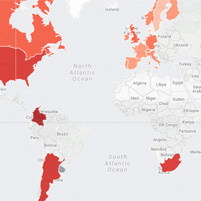Explorable Inequality
Explorable Inequality from CREATE Lab on Vimeo.

Readers of the provocative bestseller "Capital in the 21st Century," who want to take a closer look at the income database analyzed by economist and author Thomas Piketty can take advantage of an online tool created at Carnegie Mellon University.
Called Explorable Inequality, the site enables people to use an interactive map to explore and study the World Top Incomes Database compiled by Piketty and his colleagues. Users can move back and forth across more than 100 years to study tax data from 29 countries.
Using a world map to highlight wealth inequality, the interface allows people to use fever charts to focus on one country or compare several at a time, year by year.
The interface was created by the CREATE Lab in Carnegie Mellon's Robotics Institute by Randy Sargent, system scientist, and Christopher Bartley, principal research programmer. It enables large, time-sequenced data files to be rapidly explored in a manner similar to the GigaPan Time Machine, a project developed by the same team in conjunction with Google.
Piketty's book is nearly 600 pages long and densely packed with details. To make some of the information more easy to access, Bartley and Sargent presented a subset of the World Top Incomes Database information in their project. When loading the page, the data is delivered into the browser all at once.
"We did this to ensure that exploring the data is as fast as possible, with smooth animations and no delays in loading data, all motivated by improving the user experience," Bartley said.
Bartley and Sargent are interested in expanding the project and collaborating with Piketty and his colleagues.
In addition to Explorable Inequality, the CREATE Lab is working on other "Explorables." Past projects have included visualizations of suburban sprawl, fracking earthquakes and air quality indicators.
GigaPan Time Machine is a system that enables people to explore gigapixel-scale, high-resolution videos and image sequences by panning and zooming through the imagery and moving back and forth in time. Time magazine's Timelapse, a Webby-winning project for exploring 30 years of Landsat imagery of Earth, also uses this technology.
Related Links: CREATE Lab | Back to the Future | GigaPan Time Machine
